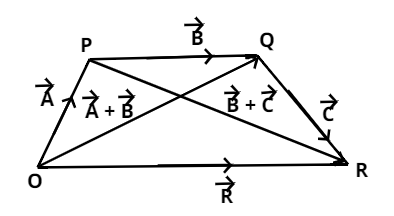
Write the associative law of addition of vectors.
Answer
530.4k+ views
Hint: Let us prove the associative law of addition of vectors by using a parallelogram with its sides as different vectors.
Complete step-by-step answer:

Now as we know that the associative law of addition of vectors states that the sum of the vectors remains same irrespective of their order or grouping in which they are arranged.
Like if
As we know that according to head to tail rule if the head of one vector joins with the tail of another vector then the sum of both vectors will be the vector formed by the joining tail of one vector with the head of another.
So, now let
So,
And,
Then finally again find the resultant of these three vectors,
So,
Applying head to tail rule,
And,
Applying head to tail rule,
Thus, using equation 1 and 2. We can say that,
Hence, this fact is known as Associative law of vector addition.
Note: Whenever we come up with this type of problem then first, we assume that the three vectors as the sides of a parallelogram and then apply head to tail rule to find the sum of the vectors and this will prove the required result. And this will be the easiest and efficient way to prove the result.
Complete step-by-step answer:

Now as we know that the associative law of addition of vectors states that the sum of the vectors remains same irrespective of their order or grouping in which they are arranged.
Like if
As we know that according to head to tail rule if the head of one vector joins with the tail of another vector then the sum of both vectors will be the vector formed by the joining tail of one vector with the head of another.
So, now let
So,
And,
Then finally again find the resultant of these three vectors,
So,
Applying head to tail rule,
And,
Applying head to tail rule,
Thus, using equation 1 and 2. We can say that,
Hence, this fact is known as Associative law of vector addition.
Note: Whenever we come up with this type of problem then first, we assume that the three vectors as the sides of a parallelogram and then apply head to tail rule to find the sum of the vectors and this will prove the required result. And this will be the easiest and efficient way to prove the result.
Recently Updated Pages
Master Class 4 Maths: Engaging Questions & Answers for Success

Master Class 4 English: Engaging Questions & Answers for Success

Master Class 4 Science: Engaging Questions & Answers for Success

Class 4 Question and Answer - Your Ultimate Solutions Guide

Master Class 11 Economics: Engaging Questions & Answers for Success

Master Class 11 Business Studies: Engaging Questions & Answers for Success

Trending doubts
Give 10 examples of unisexual and bisexual flowers

Draw a labelled sketch of the human eye class 12 physics CBSE

a Tabulate the differences in the characteristics of class 12 chemistry CBSE

Differentiate between homogeneous and heterogeneous class 12 chemistry CBSE

Why is the cell called the structural and functional class 12 biology CBSE

Differentiate between insitu conservation and exsitu class 12 biology CBSE




